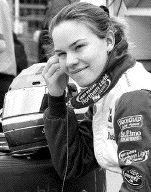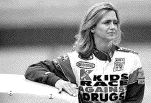

|
www.thundervalleyracing.com
|
|
Show Them the Money |
||
|
No matter how well they drive, women are still coming in last
in the competition for sponsorship dollars
Women race car drivers have made great strides in the male-dominated world of motor sports, and an increasing number of women are being drawn to motor sports as fans. Yet, the question begs: Why haven't sponsors followed? Whereas race cars driven by males are festooned with numerous corporate logos, accomplished women racers still face roadblocks in getting sponsors to come on board -- even when those sponsors market products (such as laundry detergent or pantyhose) that skew mainly toward a female demographic.
It is little wonder that Sarah Fisher was in the pits (both literally and figuratively speaking) at this year's first Indy Racing League race, the same race she drove to a second-place finish the year before. With Kroger Foods pulling its funding after the 2001 season, this year's race in Nazareth, Pa., was not as exciting for Ms. Fisher or her fans. She did, however, manage to finish fourth despite the lack of funding. It was her first time racing this season and it was for a new team. Meanwhile, at this year's running of the Daytona 500, Shawna Robinson's car was bereft of any American product logos, even though she finished a respectable 24th out of the 43 cars that took the green flag. Marketing executives agree racing fans are among the most brand-loyal of all sports fans. As the old adage goes: "Race on Sunday; sell [the cars] on Monday."
Brian McNamara, brand manager for Tide, which sponsors Ricky Craven's NASCAR car, says choosing a driver is not a "gender-based" decision. Rather, he says, such a determination is typically based on a "driver meeting the objectives of the team as well as the brand." Mr. McNamara says Procter & Gamble, which manufactures Tide, would "certainly" be open to sponsoring women racers in the future as long as certain "objectives were met." However, he did not elaborate on what those objectives are. Kellogg's admits its Special K ads are being specifically directed at women. Mark Childs, vice-president of marketing at Kellogg Canada in Toronto, says the new positioning is an evolution of the six-year-old "Look Good on Your Own Terms" campaign. It urges women to empower themselves and stay healthy and fit on their own terms. "The 'Look Good on Your Own Terms' message was one that has now become somewhat of a norm," says Mr. Childs, noting that other advertisers, such as Nike, have geared their advertising to connect with women. But do not look for Special K (or even Tony the Tiger) to be featured on Ms. Robinson's car. A mother of two, her accomplishments are renowned in racing circles: In 1994, she was the first woman to win a pole position in NASCAR's Busch Grand National Series with a track record at the Atlanta Motor Speedway. Yet, sponsors remain elusive. "Historically, there has always been a difference in male/female sports and their marketing," says Alan Middleton, a professor of marketing at Toronto's York University. But, much like equestrian events, males and females are equal competitors when it comes to motor sports. Mr. Middleton believes women racers are probably being stymied in their quest for sponsorship by a "public psyche that may be outdated. Old attitudes remain that racing is indeed a male sport, with the occasional female as an oddity." Mr. Middleton feels that companies are "missing the boat" when it comes to sponsoring female racers. "The opportunity is there and it's cheap to get in right now," he says. The marketing value of both Ms. Fisher and Ms. Robinson can be seen with the amount of media attention they garner and their large fan following. Ms. Fisher's merchandise sells better than that of many of her competitors, yet not enough for her sponsor to continue into this racing season. Gary Rhodes, a spokesman for Kroger Foods, says, "We agreed to sponsor Sarah Fisher on a test basis for a limited number of races in 2001. We fulfilled that commitment. After that, in reviewing our marketing strategy, we decided to take our marketing money in a different direction." Roman Blahoski, a spokesman for General Mills' Cheerios brand, adds: "Gender doesn't play a role in our sponsoring a sports figure; but spending and costs do. We would gladly sponsor more women and men in racing if our budget allowed for it." Paul Ferriss, associate editor of Toronto-based Marketing magazine and author of Never Too Fast: The Paul Tracy Story (ECW Press), believes sponsors are primarily attracted to winning drivers and that, currently, "there's no [woman driver] on the same level as, say, a Jeff Gordon. I think what happens in racing is that sponsors want a quick return on investment. The problem is, few women have actually won championships, and racing is still a bit of an old boys' club." Even so, Mr. Ferriss says some sponsors might be missing an opportunity by not sponsoring certain female drivers who would be very adroit at representing a company. "I don't know why there's not a woman driving the Tide car," he says. As well, Mr. Ferriss points to Canadian racer Melanie Paterson, whom he describes as "smart, intelligent and her hands aren't covered in grease. She's very groomed in terms of being media-friendly -- more than the guys are at that level of racing." Janet Guthrie -- the first woman to compete in the Indianapolis 500 and the Daytona 500 some 25 years ago -- recalls being continually frustrated by the lack of sponsorship opportunities, despite her trailblazing accomplishments on the track. "Through the late '60s to the mid '70s, I sent out proposal after proposal [to potential sponsors]," she says. "My files are filled with proposals that are so well-written, so well-researched, yet, in the end, so unsuccessful." Ms. Guthrie says her pitch was: "I'm a very experienced and successful race car driver, and the premise of sponsorship is to receive attention. And because I'm a woman, I probably receive 10 times more attention than the other guys." Alas, the response was always the same: "They [sponsorship candidates] would say: 'Great idea and we wish you success but our budget is committed,' " she says. When Ms. Guthrie aspired to compete in the Indianapolis 500 -- a goal she reached in 1977 -- she encountered numerous critics who maintained that women were "too fragile to last more than 40 laps." She proved her critics wrong. Not only did Ms. Guthrie drive the full 200 laps, but she also finished in the Top 10. Perhaps more impressive is that her team's budget was only $125,000, whereas most of the competing teams had budgets ranging from $2-million to $3-million. Yet, sponsorship funds were, as always, hard to come by. "I kept looking for sponsors through the late '70s to 1983; and I felt if I kept on doing this, I'd jump out a window." Ms. Guthrie says her personal theory on why accomplished women racers still go begging for sponsorship dollars to this day is due to the short-sightedness of male executives running companies -- even companies with products skewed toward women. "They [male executives] feel that racing is a 'macho sport' and I think there's an attitude that if they were sponsoring a car driven by a woman rather than a man, that would make it less macho," she says. "But there are definitely capable women [race car drivers] out there, and the only thing keeping them from the very top levels is sponsorship. Sarah Fisher is the most popular driver in IRL and she's a pedestrian." Ironically, after Ms. Guthrie pulled off such an impressive finish at the '77 Indianapolis 500, an editor of a motor sports magazine contacted her to ask about doing a feature story on her. But there was a catch: The magazine wanted her to pose nude on the hood of a race car. Ms. Guthrie declined the, uh, exposure. "I can't imagine why any self-respecting woman would consider this," she says, noting that the fan base at some racing series (such as IRL and NASCAR) is about 40% female. When asked what it is like being a female driver in a male-dominated sport, Ms. Fisher says: "During my entire racing career, I have never emphasized the fact that I was female. This attitude has been well respected by all of the competitors that I have raced against all the way to the IRL Series. I am not in the sport to illustrate or grow the power of women. My entire focus is on winning races. However, after all the media attention, et cetera, my side pod is still bare."
|
|
Home
| Member Area |Meet the Racers
| Features | News Articles
Sponsorship | Press Room
| Resources | About Us
| Contact Us
|


